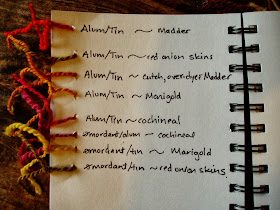 Mordants are substances that dyers use to adhere dyes to fibers. Typically dyers use alum, copper, tin, tannic acid, or iron, among others. Each of the mordants will have a different effect on the color. A mordant can brighten, dull, or change a color all together. You can add the mordant to the fiber before, during, or after the dyeing process. My mixed mordant experiment goes like this: I would pre-mordant roving, then spin it into singles, then ply together singles that had different mordants. My prediction: if I dip a multi-mordant strand into the dye it should come out with two colors, giving it a barber-pole effect.
Mordants are substances that dyers use to adhere dyes to fibers. Typically dyers use alum, copper, tin, tannic acid, or iron, among others. Each of the mordants will have a different effect on the color. A mordant can brighten, dull, or change a color all together. You can add the mordant to the fiber before, during, or after the dyeing process. My mixed mordant experiment goes like this: I would pre-mordant roving, then spin it into singles, then ply together singles that had different mordants. My prediction: if I dip a multi-mordant strand into the dye it should come out with two colors, giving it a barber-pole effect. After I dissolved a teaspoon of tin in some water I let it cool completely. I added the wool and slowly heated the mordant bath until it was simmering. I let it simmer for half an hour and then let it all cool to room temperature. I carefully rinsed the roving. Essentially there was no sudden change in temperature or agitation of the wool to prevent felting.
Next I did the same procedure with an alum mordant. After all the roving was dry I spun singles then plied the different mordant strands together.
The results were mixed. Some of the color variations were too subtle to notices. Others had the barber-pole effect that I was looking for. The yarn that I'm holding above was made with a tin/alum combination yarn dyed with red onion skins.
This pink yarn was make with one strand of alum and one strand with no mordant plied together than dyed with cochineal.
In general I don't enjoy keeping records, but I did take notes this time. One thing that I learned during this experiment is that I really like what tin does to the natural dyes. The brightest colors came from the tin.
As soon as the little skeins were dry, I rolled them into balls and started a knitting project.
.JPG)
.JPG)
.JPG)





Wow...lovely colours!
ReplyDelete